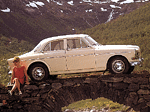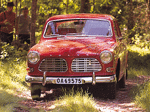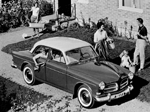
Living with the Volvo 120
By John Smith
This article is written as a guide to those who are relatively new to or who are contemplating owning a 120 series Volvo, and who wish to do the majority of the servicing and maintenance themselves. Hopefully it will give an idea of the problems, servicing information and improve-ments which can be made. The model is a popular classic car renowned for its long life and durability. Parts availability is good and there are many specialists of the model who can find replacement parts which may no longer be sold through franchised Volvo outlets. Although the youngest Amazons are now twenty seven years old they are quite able to cope with modern traffic conditions and are feasible as everyday transport. Many owners will only use them as the weekend or summer car but the following applies to both categories.
Mechanical maintenance

The good news is that one does not need a vast quantity of tools, a good set of A/F spanners and a small socket set plus a selection of screwdrivers will enable you to do most jobs. The only special tool is the rear brake puller more of which anon. (This. can be hired from David Cheshire, our 'Special Tools' Manager.
Engine
Engine oil. This should be changed every 3000 miles and the oil filter at 6000 miles. Beware of non-genuine Volvo filters which may not have a relief valve within the filter. Oil change time is a good one to check the oil filler cap, it has a breather (of fine mesh) which may need cleaning. This is easily found by undoing the Phillips screws. On the later cars with enclosed crankcase ventilation check the flame trap (remember all the correspondence in the newsletters over the past few years about this subject, especially in later 200, 300, 700 Series cars?).
Valve clearance adjustments (tappets)
This can be done whether the engine is hot or cold. Remove the valve cover and with no. 1 piston at top dead centre (TDC) one can adjust valves 1, 2, 3 and 5, and with No 4 Piston at TDC valves 4, 6, 7 and 8 can be adjusted. The clearances are .016" to .018" for B18 and B20A and for B20B .020" to .022" The adjustment is the same for both exhaust and inlet valves. The idea is that the smaller thickness feeler gauge can be inserted and the thicker cannot.
Ignition Distributor

Contact points, cheek the condition and the gap (.016-.020 inch) . Ideally, a dwell meter should be used to set the contact points - a reading of 62 degrees being the optimum. Check the distributor cap for cracks and tracking (wispy lines of carbon deposits). Check HT Leads, ensuring a tight fit into distributor cap and plugs. Smear (not too much) petroleum jelly on centre post to lubricate the cam. Lubricating oil should be fed into the small cup on side of distributor and a few drops of oil in the wick inside the rotor. I have always advocated fitting a 'Lumenition' electronic ignition system to these engines which eliminates the periodic adjustments needed and does not suffer from the gradual deterioration as happens with a conventional system. I know the purists will disagree but I will opt for efficiency every time!
Spark plugs
It is recommended that these be replaced at 12,000 miles but this will depend on the type of plug used and the type of driving the car is used for. The condition of spark plug electrode can indicate how the engine is running. The correct colour is powdery brown to greyish tan. Black and dry indicates incomplete com-bustion, rich mixture and possible defective ignition. Black and wet deposits result from oil in the combustion chamber and indicates worn piston and or rings or worn valve stems and guides.
Gearbox
The oil should be changed at 25,000 miles 1¼ pints is required. 2 7/8 pints if an overdrive is fitted and remember that draining and refilling will take longer as the oil has to drain through to both the O/D and the gearbox. The side cover plate on the O/D should be removed and the filter cleaned
Rear axle
The capacity is 2¼ pints. There is NO recommended change interval but it would seem prudent to check the level at regular intervals and replace the oil at 25,000 miles
Electrics
Batteries need maintaining. Check the electrolyte level and the tightness and cleanliness of the terminals. One weakness of the 120 series is the fuse box. Fuses can get corroded or loose so check their fit and that the very small contact area is clean - a monthly twiddle of the fuses in their holders is a ritual that helps prevent corrosion. The other weakness is that the fuse box contacts on the live side are riveted and can become loose, a dab of solder can cure this.
Brakes

Only the very early 120's had drum brakes front and rear, the remainder were fitted with front discs and rear drums until 1968 when servos were an extra and not standard except on estates and the 123GT but upon the introduction of twin circuit brakes servos were standard.
Front pad replacement
These should be changed before the pads are too thin.
Changing the pads
The split pins are removed then the pad-retaining pins pulled out. The pads can then be removed. The pistons will have to be pushed back in to the calliper to accept the thicker, new pads. Some brake fluid must be siphoned out of the master cylinder if necessary to prevent it overflowing onto the paintwork. A minute smear of 'Copaslip' grease on the back face of the new pads can help to reduce annoying brake squeal. The built-up rust rim of the discs needs to be removed carefully with a file or disc sander. The discs must be examined to ensure that they are not ridged or wearing too thin. This is a good time to check the condition of the dust seals and to ensure that the pistons are not sticking. Also check for leaks and the condition of the flexible brake pipes.
Rear brakes
In order to do any work inside drum one must first get the drum If you have never tried this before word of warning - you must use brake puller made for the job--adjustable ones with legs just cannot cope. The routine is to jack up the car firmly, and it is stressed, firmly and safely! Axle stands should be used ideally or sturdy blocks of wood NOT bricks! The rear wheel is then removed. The split pin through the end of the half shaft retaining nut is then removed and the nut taken off. The brake adjuster must then be slackened off and the puller fitted over the wheel studs and the wheel nuts tightened. The screw in the central threaded bolt is tightened until resistance is felt, then with the use of a lot of force (usually), and suddenly, bang! off comes the drum. When the drum is off one can see the condition of the drum and the brake shoes and examine the brake cylinder, replacing where necessary. Before removing the brake shoes note where everything fits: springs, handbrake cable spacers etc. Note that the brakes shoes are different for the trailing and leading shoes. It is a good plan to only remove the shoes etc. from one side at a time, so that you have a reference if necessary. While the drum is off it is a good idea to check the condition of the handbrake cable and lubricate it if needed. When replacing the drum be sure to align it correctly along the woodruff key. Ensure that the half-shaft nut is very securely tightened and replace the split pin with a new one.
Steering
The steering box oil should be checked at every 3000 miles. Top up with an SAE 80 HYPOID oil. Make regular checks on the condition of the rubbers covering the various ball jointsSome of the earlier cars will still be blessed with grease nipples on the upper and lower ball joints on the wishbones so these should be greased every 3000 miles.
Bodywork

The main areas of rusting are the front wings, and the inner wing box and the vertical section upon which the wings are bolted. Rear wheel arches, and on saloons, in the boot around the wheel arches. Also the spare wheel-well often rots. Repair panels for these areas are available as are door panel replacements. Poor windscreen seals can let in water and help introduce rust in the footwells, as well as encouraging rust in the windscreen aperture. After 25 years or so rubber seals get brittle and crack and let in water. Constant checking of the bodywork will often highlight a problem before it gets too bad. Clearing of the various drain holes in the bottom of doors and in the cills will all prolong the life of these.
Improvements and modifications to the cars
This is very much a personal thing and depends how original you wish to keep the car. Performance improve-ments from the simple adding a twin branch exhaust manifold through to fuel injection have been done. My personal 'mods' include an overdrive and a stainless steel exhaust system. I have only owned one 120 without a brake servo and was frightened at first with the pedal effort so I think a servo is essential. There is a huge range of other bolt on goodies available: stiffer springs, dampers, firmer anti roll bars, nylon suspension bushes etc. etc. Something that will come in the not too distant future is the discontinuation of leaded petrol, so modified cylinder heads (not really to be recommended) or the fitting of a device like the Broquet fuel catalyser will have to be fitted, it is also clear that emission levels will be lowered and will be strictly enforced so a properly tuned engine will be essential.
Legal | Privacy | Contact Us | Search | Site Map
Volvo Owners' Club Limited® 1962-2024

